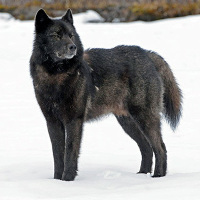 |
Alexander Archipelago wolf |
|
He is a wild animal |
Origin |
Alaska | |
Translation |
Francis Vandersteen |
| The possession of this animal is not authorized Royal Decree establishing the list of mammals not kept for production purposes that may be kept (M.B. 24.08.2009) |
| The Alexander Archipelago wolf was classified as a distinct subspecies of the gray wolf in 1937 by Edward A. Goldman. Recent taxonomic studies suggest that this subspecies may have evolved from the steppe wolf Canis lupus nubilus. The Alexander Archipelago wolf, also known as Canis lupus ligoni, is found on the southeast coast of Alaska. A large proportion of them reside in Alaska's Tongass National Forest. They can be found on the mainland from the entrance to Dixon to Yakutat Bay, and on all the main islands of the Alexander Archipelago, with the exception of Admiralty, Baranof and Chichagof. These islands are merely the peaks of submerged coastal mountains with steep, craggy shores. They are densely wooded and teem with wildlife. Many wolves travel freely between islands, and their ranges can change significantly over time. This makes accurate population monitoring difficult. This subspecies of wolf is relatively isolated from other wolves by mountains and water barriers. These "island wolves" are small, short-haired wolves, generally black or a rather dark color. They average around 1 m in length, 61 cm in height, weighing from 13.5 kg to 22.5 kg. Taxonomist Goldman described the Alexander Archipelago wolf as being smaller and having shorter, coarser, darker hair than wolves in the northern and interior regions of Alaska. Alexander Archipelago wolves feed mainly on Sitka black-tailed deer. They also feed on moose, beaver, mustelids, other small mammals and birds. Researchers have learned in recent years that some wolf packs also spend a surprising amount of time feeding on salmon. In Southeast Alaska, pups are usually born in the last two weeks of April. Dens are usually built 4-5 weeks before birth, between tree roots, in small caves or crevices in rocks, in abandoned beaver lodges or in expanded mammal burrows. Wolves in Alaska have been under attack since the 1940s. A federal campaign of poisoning and aerial shooting began after the Second World War. By the mid-1950s, the government had drastically reduced wolf numbers in much of south-central and interior Alaska. While poisoning was banned after statehood in 1959, aerial shooting and bounty payments continued throughout the 1960s. After the passage of the Federal Airborne Hunting Act in 1972 and the end of the bounty, wolf numbers increased. By the mid-1970s, hunters were demanding state-sponsored wolf control, and the Alaska Department of Fish and Game responded with helicopter shooting programs. Considerable public opposition put an end to these state-sponsored programs, but hare hunting by private hunters continued throughout the 1980s and into the early 1990s. The current wolf population of the Alexander Archipelago is estimated at between 750 and 1,100. |






 English (United Kingdom)
English (United Kingdom)